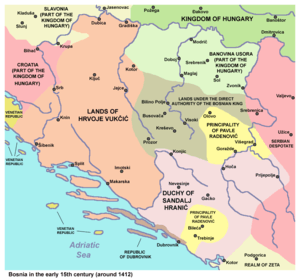Sandalj Hranić
| Sandalj Hranić | |
|---|---|
| Grand Duke of Bosnia | |
| Reign | 1392—1435 |
| Predecessor | Vlatko Vuković |
| Successor | Stjepan Vukčić Kosača |
| Spouse(s) |
|
| Born | 1370 |
| Died | 15 March 1435 |
Sandalj Hranić Kosača (Cyrillic: Сандаљ Хранић Косача; 1370 – 15 March 1435) was a Bosnian[1] magnate who ruled the area between Neretva and Drina rivers in Bosnia with the title Grand Duke of Bosnia between 1392 and his death in 1435. He was married three times, but had no children. After his death, he was succeeded by his nephew Stjepan Vukčić Kosača.
Marriages and foreign policy

As the head of the House of Kosača, Sandalj Hranić succeeded his uncle Vlatko Vuković in 1392.
In 1403, Radič Sanković led the attacks on Dubrovnik during the Bosnian-Ragusan War in the name of King Stephen Ostoja. Sandalj Hranić captured and blinded Radič, and held him in prison until his death in 1404.[2]
When King Ladislaus of Naples sold his rights to the kingdom of Dalmatia to the Republic of Venice and retreated from the Balkans in 1409, many local nobles allied themselves with Holy Roman Emperor Sigismund and accepted Stephen Ostoja as King of Bosnia. This seriously weakened the position of Hrvoje Vukčić Hrvatinić, whose niece Katarina was Sandalj's second wife. In such circumstances Sandalj also allied with Emperor Sigismund in mid 1411 and decided to establish closer connections with Sigismund's important ally Stefan Lazarević by marrying his widowed sister Jelena.[3] Sandalj divorced Katarina in December 1411 and married Jelena at the end of the same year.[4][5][6] This marriage had its important political consequences because Hranić, the most dangerous enemy of Balša III, became his stepfather and protector.[7] With this marriage Hranić spoiled the relations with Hrvoje but strengthened traditionally close relations with Lazarević family.[8] Jelena went to live with her husband in Herzegovina and Balša remained as the only governor of Zeta.[9] Although Jelena was ih her forties, Sandalj left a deposit in Dubrovnik for a son or daughter he hoped they would have.[10]

After 1419 Sandalj became the most powerful man in the Kingdom of Bosnia. After he took part in the conspiracy to kill Pavle Radenović in 1415, Hranić came in conflict with Pavlović family. In fighting against them, he allied with Ottoman Empire. In 1420 Ishak Bey organized unsuccessful campaign in Bosnia to support Sandalj's struggle against his enemies.[11]
At the beginning of February 1426 a special ceremony was dedicated to Duke Sandalj and Duchess Jelena in Dubrovnik, when they attended the feast of Saint Blaise, the city's patron saint.[12] Sandalj often had conflicts with King Stephen Tvrtko II, even refusing to attend his wedding to the Hungarian-born Dorothy Garai in 1428.
Sandalj died childless in 1435. He was succeeded by his nephew Stjepan Vukčić Kosača, son of his brother Vukac.
References
- ↑ Naimark, Norman M. Yugoslavia and Its Historians: Understanding the Balkan Wars of the 1990s. Stanford University Press. p. 56. ISBN 0804745943.
- ↑
- ↑ Bešić 1970, p. 189
Повлачење Ладислава Напуљског нагонило јебосанског краља и обласне господаре да се приближе Жигмунду.Сандаљ Хранић је већ крајем љета 1411. год. био на његовојстрани. Садшм тим успоставио је најбоље односе са српским дес-потом Стефаном.
- ↑ Fine 1975, p. 233
...Sandalj divorced Hrvoje's niece and shortly thereafter married Jelena...
- ↑ Veselinović 2001, p. 96
Њему се прикључио 1411 и војвода Сандаљ Хранић. Крајем те исте године Балшина мајка Јелена се преудала за војводу Сандаља.
- ↑ Spremić 2004, pp. 73–108
...Јелена се 1411. удала за босанског војводу Сандаља Хранића. Он је у децембру исте године напустио своју прву жену Катарину...
- ↑ Spremić 2004, pp. 73–108
До тада најопаснији противник Балше III, постао је његов очух и заштитник.
- ↑ Fine 1975, p. 467
...This marital change reflected both Sandalj′s deteriorating relations with Hrvoje and his forging closer ties with Serbia. ... Good relations with Kosače and Stefan′s family were not new ...
- ↑ Spremić 2004, pp. 73–108
Када је пошла новом мужу, Јелена је имала четрдесетак година.... Јелениним одласком у Босну, у Зети је остао да влада Балша III, и даље веран идејама своје мајке
- ↑ Spremić 2004, pp. 73–108
Када је пошла новом мужу, Јелена је имала четрдесетак година....Остављајући у мају 1413. поклад у Дубровнику, предвидео је да га може подићи ако за њим остане "или син или девојка које би имао с реченом госпођом Јеленом", што показује да се није искључивала могућност да њих двоје имају деце.
- ↑ M. Bešić, Zarij (1970), Istorija Crne Gore / 2. Crna gora u doba oblasnih gospodara. (in Serbian), Titograd: Redakcija za istoiju Crne Gore, p. 123, OCLC 175122851,
Већ сљедеће године кренуо је скопски намјесник Исхак у Босну да сатре Сандаљеве противнике, које је подржавао босански краљ.Ништа он није ни могао предузети против Сандаљевог пасторкаи вјерног султановог харачара Балше III.
- ↑ Spremić 2004, pp. 73–108
Дубровчани су, по посебном церемонијалу, приредили војводи Сандаљу и Јелени свечани дочек првих дана фебруара 1426. године. Том приликом, Јелена је присуствовала највећој свечаности у Дубровнику, прослави Светог Влаха
Sources
- Fine, John Van Antwerp (December 1975), The Bosnian Church: a new interpretation : a study of the Bosnian Church and its place in state and society from the 13th to the 15th centuries, East European quarterly, ISBN 978-0-914710-03-5, retrieved 12 January 2013
- Veselinović, Andrija; Radoš Ljušić (2001), (in Serbian), Belgrade, Novi Sad: Platoneum, ISBN 9788683639014, OCLC 50393016 Missing or empty
|title=(help) - Spremić, Momčilo (2004), Ćulibrk, Jovan, ed., Crkvene prilike u Zeti u doba Nikona Jerusalimca (in Serbian), Cetinje, Belgrade: Svetigora, Publikum, pp. 73–108
| Preceded by Vlatko Vuković |
Grand Duke of Bosnia 1392–1435 |
Succeeded by Stjepan Vukčić Kosača |